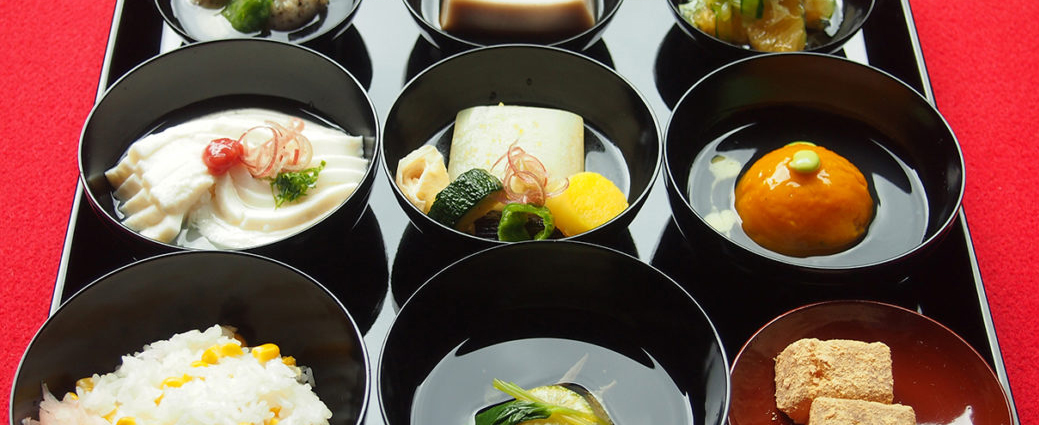Vegetarian Survival Guide
Though Japanese cuisine is famed for its healthiness and its focus on vegetables and seasonal produce, it is far from a vegetarian’s paradise. For fish eaters, the options are nearly limitless. Things are trickier for non pesco-vegetarians: dried fish, in the form of katsuo bushi, forms the base to most sauces and nearly all soup dishes, and lurks in some of the safest looking dishes. Meat and fish are generally thought to improve foods greatly. To make things harder, a number of foods normally slated as vegetarian are not: fish-based dashi hides in the sweet or savoury Japanese omelettes, in the base for okonomiyaki pancakes, and often in the sauce added to the otherwise vegan sticky soybean natto.
All is not lost, however. In the bigger cities, there tend to be a number of speciality vegetarian restaurants, particularly macrobiotic and organic eateries which are increasingly popular. Western style cafes tend to have at least one vegetarian sandwich or wrap option.
Traditional Japanese food is by no means completely out of your reach. Shojin-ryori, or temple cuisine, is vegan by tradition, using mushrooms and kelp as the stock base and excluding all meat and fish products. Widely available in Kyoto, shojin-ryori is gourmet indeed, and considered to be some of the finest Japanese food available. A shojin-ekiben or boxed lunch is also available at Kyoto train station.
Oddly enough, izakaya style pubs and yakitori-ya and yaki-niku barbeque restaurants are some of the easiest places to order vegetarian dishes. A wide variety of food is served in small portions, so it’s also a great way to try a number of different dishes.
Vegetarian izakaya standbys include hiya-yakko tofu (make sure to ask for no katsuo), tomato salad, traditional Japanese tsukemono pickles, edamame; and rice balls with salted plum: ume onigiri. Pizza and chips, or furaido potato, are also fairly standard, and asking for meatless and fishless dishes can be extremely rewarding.
At the Yakitori-ya, skewers of shiitake mushrooms, ginnan (chewy gingko nuts), negi (leaks) and quail eggs are available everywhere, and other vegetables are grilled in season. Yaki-niku restaurants have plenty of grill-it-yourself vegetable and tofu options, as well as tasty side dishes of kimchee and salads.
Tempura restaurants are a perfectly valid option: the oil used for frying is vegetable oil, and, though sets usually feature prawns or other seafood, it is possible to ask for vegetables only, seasoned with salt (shio) rather than the fish-based dipping sauce.
Deep fried kushi-age also has some decent vegetable options, from aubergine to lotus root to camembert cheese, which are usually topped with bulldog sauce and traditionally washed down with beer.
Although soba and udon noodle restaurants use a fish based stock in sauces and soups, cold noodles are served with the sauce on the side, and are delicious by themselves topped with a little soy sauce instead.
Sushi, although not as vegetarian-friendly as in the west, always offers cucumber kappa-maki rolls, inari (in a tofu skin), kanpyou gourd, salty plum umeshiso-maki rolls, and sometimes avocado rolls. Going to a cheap kaiten-zushi, or revolving sushi, bar is a pressure-free way to try the vegetarian options (including creamed corn and aubergine pickle), as you can either wait for them to come around on the conveyer belt or order them off the menu directly.
Western style chains, such as Denny’s, Royal Host, and Skylark (Gusto) rarely have vegetarian dishes: most salads include fish or meat, and most of the vegetable soups contain meat or ham. However, Japan’s best answer to hamburger chains, MOS Burger, offers a vegetarian kinpira rice burger. Indian and Italian restaurants are also popular throughout the country, and serve familiar vegetarian dishes.
At Into Japan we understand the challenges of dining in Japan, and are more than happy to make reservations at vegetarian restaurants or at temples for shojin-ryori for you during your visit to Japan.
Japanese Food
Contact us
Tel: 01865 841443
Fax: 01865 841445
Into Japan Specialist Tours
The Dovecote, Manor Farm, Ball Lane, Tackley, Oxfordshire OX5 3AG

